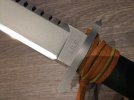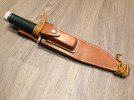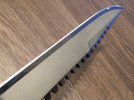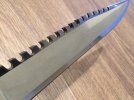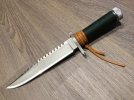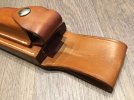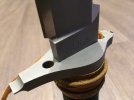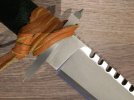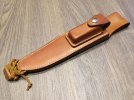I always thought the Buckmaster was a functional design but much too short and too heavy (and with a somewhat clunky sheath).
Here is a new favourite of mine, the Parker-Imai K-692, which to my eyes addresses at least some of the Buckmaster issues:
Blade length is 9.8 inches. Weight is 28 ounces, even heavier than the Buckmaster's 24 ounces...
It appears most of the extraordinary weight of these types of knives is due to the attachment system within the handle, although the thick low sabre ground blade, and strong point, also contributes to this. I would say, from examining mine, that this general "Buckmaster type" construction makes for the strongest hollow handles ever built, and probably among the strongest knives period... Very early Buckmasters had non-annealed tangs that could be brittle when struck on an anvil, but for normal use it doesn't seem all that relevant...
The particular knife I own is not a Parker brand, but the identical model simply marked "Japan" on one side, and "440 stainless" on the other. Of all the Buckmaster clones this is the one that matches the most exactly the burly Buck construction, right down to the guard thickness, which most clones skimp on... The only difference being that here the guard's edges are left in their rough unfinished stamped finish, which accentuates the brutally "industrial" look of the knife... In fact, I have never seen such a well-built knife that proclaims more loudly "I am an industrial product"... Even the sawback is unique in that the teeth are not machined, but stamped along with the blade outline in one step: This is what gives them this peculiar widely spaced look... They work adequately for notches, and I doubt the Buck design is any better... Unfortunately the stamping process rounds their corners slightly on one side, but the biggest drawback to performance is the sabre grind compared to a full flat grind: They still work adequately for making 1/4" notches, while the Lile sawback will do 3/4" in equal circumstances.
One thing I really like about the sawback design is that it stays well forward and away from the guard, which shows some serious consideration about actual use... Nothing annoys me more than to see a sawteeth hiding under the guard, except maybe the endemic silly "Rambo" notches in the clip, which this knife also avoids... This knife is actually closest to how I would have designed a "Survival Knife", except for the weight...
I paired mine with a modified sheath for the Gerber BMF, increasing the sheath's length by adding a "spacer" at the sheath mouth, the result being outstanding...
The best thing about this knife is the edge geometry, very unusual for a Japanese factory "tactical" or "outdoor" type knife; Those often tend to be thick edged, even the convexed ones like the San Mai III Trailmaster: It is 0.020" at the edge shoulders, very much like a Randall. This is the knife that finally tilted the balance towards "Sabre Hollow Grinds" for "Survival Knives" in my mind, the Randall Model 12 being an earlier argument in their favour... (This $180 knife made me sell my $900 Randall to take its place in the BMF sheath, which should tell you something... And the Randall had
nothing wrong with it, except for not being a hollow handle...)
The reason for that tilt towards Hollow Grinds is that, despite having higher blade weights and less efficient sawbacks compared to Full Flat Grinds, I found that slicy Full Flat Grinds (and for me that begins at under 0.030" at the edge shoulders, and just under 15 degrees per side) can often sink deeper while chopping into wood, to the point the slicy Full Flat Grind edge becomes so severely "pinched" that any accidental lateral movement when "unsticking" can cause damage to the apex, typically a pair of tiny chips spaced evenly from the vertical axis of the accidental "twist". This doesn't happen to Sabre Hollow Grinds because 1-The sabre grind acts as a "brake", which reduces apex "pinching", and 2-The flare of the hollow grind spreads the wood,
or displaces the blade upwards, when there is accidentally twisting, which protects the apex from lateral loads.
Sure, "Full Flat Grinds" perform better while chopping wood,
especially on an equivalent weight basis, but with thin edges they are a bit like race cars that don't tolerate mishandling: At equivalent slicing ability, their apex is more vulnerable to lateral loads when unsticking from wood. For "Survival" purposes, where you might be tired, and carelessly unsticking your knife after a chop, the less finicky hollow grind will definitely stand up better, all else being equal. Even with careful "unsticking", the Full Flat Grind does not really perform that much better than a Sabre Hollow Grind: I find the edge apex fragility much greater, especially when the Full Flat Grind blade approaches 2" in width, as it can then "pinch" itself precariously deep into the wood...: The performance has a cost in edge fragility that is not worth it in my opinion, although this can be alleviated a bit by opening the edge from 12-14 to 17-18 degrees per side...
That being said, probably the biggest functional difference between the two grinds is the weight, typically on a 10" blade the Full Flat grind will be around 17-20 ounces, while a similar 10" Sabre Hollow Grind will be typically come in at around 22-26 ounces, a
very noticeable difference. That alone could justify the lighter grind. But everything has a cost, so make sure you unstick it straight...
Gaston





